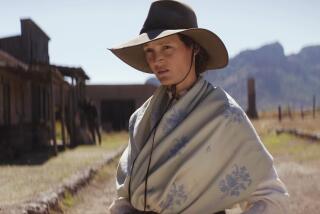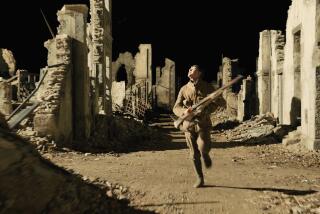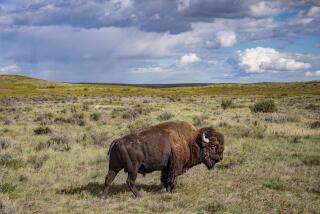Forget this ‘Alamo’
Apart from John Wayne, who says we should remember the Alamo? The Daughters of the Republic of Texas, official guardians of the historic battleground, want us to remember the monument as “the symbol of heroic courage in the face of death and the struggle against oppression.” And the makers of the new movie about the 13-day siege, which like Wayne’s 1960 epic is titled “The Alamo,” doubtless would like us to remember the battle all the way to the box office. Likely that explains why the tagline for their film -- “you will never forget” -- sounds more like a threat than a promise.
A rather feeble threat, as it happens. Directed by John Lee Hancock (“The Rookie”) with high-minded seriousness and an old-fashioned hard studio sell, and written by Hancock, Leslie Bohem and Stephen Gaghan for a minimum of offense, this Alamo film arrives with little of the flag- and gun-waving histrionics that make Wayne’s spectacle such rich, lugubrious comedy. To that end, gone are the Duke’s stirring calls to coded Cold War patriotism. Gone too are Davy Crockett’s coonskin hat and even the name Davy, since in the new film, Billy Bob Thornton’s self-aware frontiersman prefers to be known as David. Just as important, gone are the sassy Mexican senoritas fluttering their Max Factor lashes and the anonymous storm-trooping Mexican hordes unloading their guns at the few, the proud, the Texan.
Told principally in flashback, the story begins its slow boil with the various principals converging in and around the Alamo in early 1836. Like almost every other bloodstained scene out of the American past, the historic site has long been contested, its significance and meaning shifting with changing political winds. In the classic storybook version, about 200 American frontiersmen fight against the entire Mexican army for truth, justice and the Texan way, which mostly seems to involve grabbing large swaths of land for as little money as possible. In the revised story, one followed fairly attentively by the latest “Alamo” filmmakers, these 200 besieged include Texan immigrants, Tejanos (Texans of Mexican decent) and American volunteers who are engaging in the larger fight for independence by standing up to the well-armed Mexican president, Antonio Lopez de Santa Anna.
Played by Emilio Echevarria with a broad leer and mincing table manners -- he’s the kind of villain who orders the slaughter of innocents while daintily holding a China teacup -- the extravagantly wicked and entertaining head of the Mexican army makes a fine match to Thornton’s Crockett. (As the president’s principled, often-appalled aide-de-camp, Castulo Guerra carves out his own corner of the film.) Arriving at the Alamo almost by happenstance, Crockett quickly becomes the only point of interest in the fort, as much for his humanity as for his bigger-than-life shadow. As Gen. Sam Houston (Dennis Quaid) tries to raise an army outside the fort and Col. James Bowie (Jason Patric) and Lt. Col. William Travis (Patrick Wilson) squabble over the leadership of the meager forces inside, Crockett -- and Thornton -- shows how a man can become a legend.
Unlike Patric and especially Quaid, both of whom affect the kind of grim determination often found in laxative commercials, Thornton plays his part for the movie moment, not for history. Resigned to never living up to his legend, his Crockett is at once a fallible man and king of the wildly mythic frontier, and the actor perfectly fulfills the need for the character to be both empathetic and entertaining. So much so that whenever Thornton tucks another scene inside his pocket, a wry smile tugging at the corners of his mouth, you wish the filmmakers had kept Bowie and Travis sidelined. The actor even keeps you hooked after he delivers one of the most cringe-worthy speeches in recent movie memory, capping a grisly story about potatoes cooked in human fat with the comment that these days, he always “passes on the taters.”
History may offer up the proof, but for all the gun smoke, the image of the fort’s defenders silhouetted against a blood-red Texas sky and the unrelenting bombast of Carter Burwell’s score, the filmmakers never make the case why we should remember the Alamo, especially now.
Houston eventually led his army against Santa Anna and remembered his dead compatriots by killing more than 600 Mexican soldiers in 18 minutes. Hancock reproduces this scene of appalling vengeance with a sense of manifest distress; he’s clearly bothered by the image of Texas bullets tearing into Mexican backs, although not enough to go full revisionist bore. There’s the rub. Driven by different agendas, history and movies often tell two irreconcilable stories, which is why, despite some glints of talent, Hancock has given us yet another film and another Alamo to forget.
*
‘The Alamo’
MPAA rating: PG-13, for sustained, intense battle sequences
Times guidelines: Gun and bayonet violence though little visible blood
Dennis Quaid...Sam Houston
Billy Bob Thornton...David Crockett
Jason Patric...Jim Bowie
Patrick Wilson...William Travis
Emilio Echevarria...Antonio Lopez de Santa Anna
A Touchstone Pictures and Imagine Entertainment presentation, released by Touchstone Pictures. Director John Lee Hancock. Writers Leslie Bohem, Stephen Gaghan, John Lee Hancock. Producers Mark Johnson, Ron Howard. Director of photography Dean Semler. Production designer Michael Corenblith. Editor Eric L. Beason. Costume designer Daniel Orlandi. Music Carter Burwell. Casting Ronna Kress. Running time: 2 hours, 16 minutes. In English and Spanish with English subtitles. In general release.
More to Read
Only good movies
Get the Indie Focus newsletter, Mark Olsen's weekly guide to the world of cinema.
You may occasionally receive promotional content from the Los Angeles Times.










